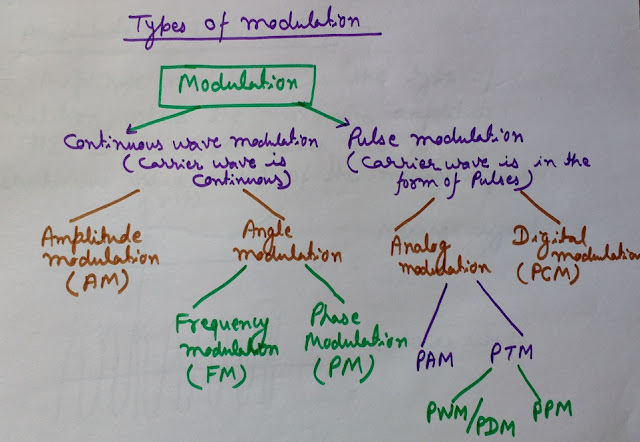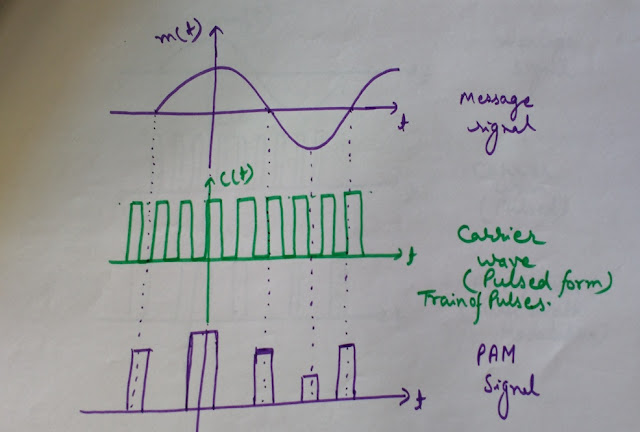In this post we will discuss Pulse Amplitude Modulation (PAM). Pulse Amplitude Modulation is a pulse modulation technique. Other techniques of analog pulse modulation are- Pulse Width Modulation (PWM) and Pulse Position Modulation (PPM). But before discussing pulse amplitude modulation, it is important to know, what is pulse modulation and how it is different from continuous wave modulation.
🌓READ THIS ALSO:-
#NEED AND BENEFITS OF MODULATION
🌓READ THIS ALSO:-
#NEED AND BENEFITS OF MODULATION
Pulse Amplitude Modulation Video [HD]
Difference between Pulse Modulation and Continuous Wave Modulation
In pulse modulation, some parameter (amplitude, width or position) of the pulsed carrier wave is varied as per the instantaneous value of the modulating signal (message signal). Types of analog pulse modulation techniques are- Pulse Amplitude Modulation (PAM), Pulse Width Modulation (PWM) and Pulse Position Modulation (PPM).
While continuous wave modulation is a technique of modulation where some parameter (amplitude, frequency or phase) of a sinusoidal carrier is varied in accordance with the instantaneous value of the modulating signal.
🌓READ THIS ALSO:-
COMPARISON OF PAM, PWM, PPM MODULATION TECHNIQUES
Types of continuous wave modulation are- Amplitude modulation (AM), Frequency Modulation (FM) and Phase Modulation (PM).
🌓READ THIS ALSO:-
COMPARISON OF PAM, PWM, PPM MODULATION TECHNIQUES
Types of continuous wave modulation are- Amplitude modulation (AM), Frequency Modulation (FM) and Phase Modulation (PM).
See the image given below to understand different types of modulation techniques. Click the image to enlarge it-
Classification of Modulation Techniques
 |
| Classification of Modulation Techniques |
Pulse Amplitude Modulation (PAM)
In pulse amplitude modulation, the amplitude of pulsed carrier wave is varied according to the modulating signal.
Pulse Time Modulation (PTM)
In pulse time modulation, the timing of pulses of the pulsed carrier is varied. Therefore the variations in the pulse are on the time axis.
Pulse Time Modulation (PTM) is of two types-
Pulse Position Modulation (PPM)
Pulse Width Modulation (PWM)
In PWM, the width of pulsed carrier wave is varied as per the instantaneous value of the modulating signal.
Pulse Position Modulation (PPM)
In PPM, the position of pulsed carrier is varied as per the modulating signal (message signal).
Now we understand the basic difference between PAM, PWM and PPM. Now it's time to discuss pulse Amplitude Modulation in some detail-
Pulse Amplitude Modulation (PAM)
Definition:-
The modulation technique in which the instantaneous amplitude of the pulsed carrier is varied according to the modulating signal (message signal) is called as pulse amplitude modulation (PAM).
Waveform of Pulse Amplitude Modulation (PAM)
Look at the image given below carefully to understand the formation of pulse amplitude modulated wave. (Click the image to enlarge)-
 |
| Pulse Amplitude Modulation (PAM) Waveform |
Here in this image, you can see, three waveforms.
🌓READ THIS ALSO:-
#SAMPLING THEOREM AND RECONSTRUCTION (SAMPLING AND QUANTIZATION)
#Watch the VIDEOS PLAYLIST here (Pulse modulation Techniques)
The first waveform is of modulating signal (message signal), the second one is of the pulsed career wave and the third waveform is of the pulse amplitude modulated wave (PAM).
🌓READ THIS ALSO:-
#SAMPLING THEOREM AND RECONSTRUCTION (SAMPLING AND QUANTIZATION)
#Watch the VIDEOS PLAYLIST here (Pulse modulation Techniques)
The first waveform is of modulating signal (message signal), the second one is of the pulsed career wave and the third waveform is of the pulse amplitude modulated wave (PAM).
The message signal can have multiple frequencies and variable amplitude. Here we have used a sinusoidal message signal. The carrier wave that we have used here, is a train of pulses having high frequency. Since we know that in Pulse modulation, the carrier wave is in the form of pulses.
Now we will understand how can we make pulse amplitude modulated wave (PAM).
🌓READ THIS ALSO:-
#AMPLITUDE MODULATION (TIME DOMAIN EQUATIONS AND WAVEFORMS)
#FREQUENCY SPECTRUM OF AMPLITUDE MODULATION (WAVEFORMS AND EQUATIONS DERIVATION)
As we have discussed that in Pulse amplitude modulation, the instantaneous amplitude of the pulsed carrier is varied according to the modulating signal (message signal). Now look at the image shown above very carefully, observe that, as the amplitude of the modulating signal (message signal or baseband signal) increases, the amplitude of the pulsed carrier wave increases and becomes maximum when the amplitude of the modulating signal reaches at its maximum. Now the amplitude of the carrier wave starts decreasing with decrease in amplitude of the modulating signal. So it is clear from the image that the amplitude of the pulsed carrier wave varies according to the instantaneous value of the message signal.
Important Observations about Pulse Amplitude Modulation (PAM)
#As it is Pulse Amplitude Modulation (PAM), therefore only the amplitude of the pulsed carrier changes.
#There is no change in the width or position of the pulsed carrier wave. So the width and position of the carrier wave pulse is constant here.
🌓READ THIS ALSO:-
#Digital Modulation Techniques (ASK, FSK, PSK, BPSK)/ Amplitude, Frequency and Phase Shift Keying
🌓READ THIS ALSO:-
#Digital Modulation Techniques (ASK, FSK, PSK, BPSK)/ Amplitude, Frequency and Phase Shift Keying
#Therefore all the information of the modulating signal is contained in the amplitude variations of the pulses. No information is present in the width or position of the pulses.
Read More-
Go To HOME Page
FREQUENCY SPECTRUM OF AMPLITUDE MODULATION (WAVEFORMS AND EQUATIONS DERIVATION)
AMPLITUDE MODULATION (TIME DOMAIN EQUATIONS AND WAVEFORMS)
ADVANTAGES AND DISADVANTAGES OF DIGITAL COMMUNICATION SYSTEM
ADVANTAGES OF OPTICAL FIBER COMMUNICATION
STEP INDEX OPTICAL FIBER (MULTIMODE AND SINGLE MODE STEP INDEX FIBERS)
PULSE MODULATION TECHNIQUES (PAM, PWM, PPM, PCM)
OPTICAL FIBER: STRUCTURE AND WORKING PRINCIPLE
PULSE AMPLITUDE MODULATION (PAM)
COMPARISON OF PAM, PWM, PPM MODULATION TECHNIQUES
PULSE WIDTH MODULATION (PWM)
CONTINUOUS TIME AND DISCRETE TIME SIGNALS (C.T. AND D.T. SIGNALS)
NEED AND BENEFITS OF MODULATION
PULSE POSITION MODULATION (PPM)
OPTICAL FIBERS IN COMMUNICATION: COVERS ALL IMPORTANT POINTS
OPTICAL FIBER SOURCES (DESIRABLE PROPERTIES)
AMPLITUDE MODULATION Vs FREQUENCY MODULATION (ADVANTAGES AND DISADVANTAGES)
PULSE CODE MODULATION (PCM) [ADVANTAGES AND DISADVANTAGES]
SAMPLING THEOREM AND RECONSTRUCTION (SAMPLING AND QUANTIZATION)
SUPERPOSITION THEOREM (BASICS, SOLVED PROBLEMS, APPLICATIONS AND LIMITATIONS)
Digital Modulation Techniques (ASK, FSK, PSK, BPSK)/ Amplitude, Frequency and Phase Shift Keying
Conventional AM Vs DSB-SC Vs SSB-SC Vs VSB (Comparison of AM Systems)
Quadrature Amplitude Modulation (QAM)/ QAM Transmitter and QAM Receiver Block Diagram
Single-Mode Optical Fiber Advantages
What are Microwaves and their Applications (Uses) in various fields
Microwaves Properties and Advantages (Benefits)
Basic Structure of Bipolar Junction Transistor (BJT) - BJT Transistor - Working and Properties
Polar Plots of Transfer Functions in Control Systems (How to Draw Nyquist Plot Examples)
Generation of Binary Phase Shift Keying (BPSK Generation) - Block Diagram of Binary Phase Shift Keying (BPSK)
Low Level and High Level Modulation Block Diagram (AM Transmitter Block Diagram)
Block Diagram of CRO (Cathode Ray Oscilloscope), Components of CRO and CRT with Structure and Working
Slope Overload Distortion and Granular (Idle Noise), Quantization Noise in Delta Modulation
Frequency Translation/Frequency Mixing/Frequency Conversion/Heterodyning (Basic Concepts and Need)
Quadrature Phase Shift Keying Modulation (QPSK) Basics, Waveform and Benefits
Pulse Code Modulation (PCM) Vs Differential Pulse Code Modulation (DPCM)
Read More-
Go To HOME Page
FREQUENCY SPECTRUM OF AMPLITUDE MODULATION (WAVEFORMS AND EQUATIONS DERIVATION)
AMPLITUDE MODULATION (TIME DOMAIN EQUATIONS AND WAVEFORMS)
ADVANTAGES AND DISADVANTAGES OF DIGITAL COMMUNICATION SYSTEM
ADVANTAGES OF OPTICAL FIBER COMMUNICATION
STEP INDEX OPTICAL FIBER (MULTIMODE AND SINGLE MODE STEP INDEX FIBERS)
PULSE MODULATION TECHNIQUES (PAM, PWM, PPM, PCM)
OPTICAL FIBER: STRUCTURE AND WORKING PRINCIPLE
PULSE AMPLITUDE MODULATION (PAM)
COMPARISON OF PAM, PWM, PPM MODULATION TECHNIQUES
PULSE WIDTH MODULATION (PWM)
CONTINUOUS TIME AND DISCRETE TIME SIGNALS (C.T. AND D.T. SIGNALS)
NEED AND BENEFITS OF MODULATION
PULSE POSITION MODULATION (PPM)
OPTICAL FIBERS IN COMMUNICATION: COVERS ALL IMPORTANT POINTS
OPTICAL FIBER SOURCES (DESIRABLE PROPERTIES)
AMPLITUDE MODULATION Vs FREQUENCY MODULATION (ADVANTAGES AND DISADVANTAGES)
PULSE CODE MODULATION (PCM) [ADVANTAGES AND DISADVANTAGES]
SAMPLING THEOREM AND RECONSTRUCTION (SAMPLING AND QUANTIZATION)
SUPERPOSITION THEOREM (BASICS, SOLVED PROBLEMS, APPLICATIONS AND LIMITATIONS)
Digital Modulation Techniques (ASK, FSK, PSK, BPSK)/ Amplitude, Frequency and Phase Shift Keying
Conventional AM Vs DSB-SC Vs SSB-SC Vs VSB (Comparison of AM Systems)
Quadrature Amplitude Modulation (QAM)/ QAM Transmitter and QAM Receiver Block Diagram
Single-Mode Optical Fiber Advantages
What are Microwaves and their Applications (Uses) in various fields
Microwaves Properties and Advantages (Benefits)
Basic Structure of Bipolar Junction Transistor (BJT) - BJT Transistor - Working and Properties
Polar Plots of Transfer Functions in Control Systems (How to Draw Nyquist Plot Examples)
Generation of Binary Phase Shift Keying (BPSK Generation) - Block Diagram of Binary Phase Shift Keying (BPSK)
Low Level and High Level Modulation Block Diagram (AM Transmitter Block Diagram)
Block Diagram of CRO (Cathode Ray Oscilloscope), Components of CRO and CRT with Structure and Working
Slope Overload Distortion and Granular (Idle Noise), Quantization Noise in Delta Modulation
Frequency Translation/Frequency Mixing/Frequency Conversion/Heterodyning (Basic Concepts and Need)
Quadrature Phase Shift Keying Modulation (QPSK) Basics, Waveform and Benefits
Pulse Code Modulation (PCM) Vs Differential Pulse Code Modulation (DPCM)
